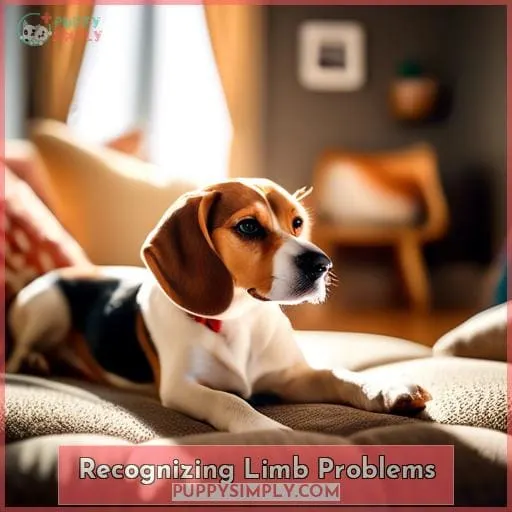This site is supported by our readers. We may earn a commission, at no cost to you, if you purchase through links.

You’re likely curious if these athletic canines can safely navigate this daily ascent.
Indeed, Huskies can climb stairs, but there’s more to it than just scaling up and down.
From their puppyhood to their senior years, understanding the nuances of stair safety, training, and health is crucial.
Let’s delve into how you can guide your Husky on this journey, ensuring their well-being every step of the way.
Table Of Contents
- Key Takeaways
- Huskies and Stair Climbing
- Stair Safety for Huskies
- Training Huskies on Stairs
- The One Year Guideline
- Recognizing Limb Problems
- Huskies With Stair Phobia
- Preventing Stair Phobia
- Stairs and Husky Health
- Senior Huskies and Stairs
- Alternatives to Stairs
- Frequently Asked Questions (FAQs)
- What are some common health issues in Huskies that might affect their ability to climb stairs?
- How can I help my Husky overcome a fear of stairs?
- Are there specific exercises or activities that can help strengthen my Husky’s joints for stair climbing?
- How can I modify my stairs to make them safer and easier for my Husky to navigate?
- What are some signs that my Husky might be experiencing discomfort or difficulty when climbing stairs?
- Conclusion
Key Takeaways
- Huskies are athletic and generally capable of climbing stairs, but puppies under one year should avoid frequent stair use to prevent joint problems.
- To ensure stair safety, it’s recommended to have carpeted or non-slip stairs, maintain good lighting, and keep the area free of clutter.
- Training Huskies to use stairs should involve positive reinforcement, a gradual approach, and patience to help them build confidence and overcome any fear.
- For senior Huskies or those with joint health issues, alternatives like ramps or supportive harnesses should be considered to ease the strain on their joints.
Huskies and Stair Climbing
When it comes to Huskies and stair climbing, there are a couple of key factors to consider:
- The age of the dog
- The breed’s characteristics
For young Huskies, climbing stairs can put strain on their developing joints, so it’s often recommended to limit their stair use until they’re about a year old.
On the other hand, adult Huskies, known for their energy and agility, can usually handle stairs without issue, but it’s still important to monitor for any signs of discomfort or difficulty.
Age Considerations
One should consider a Husky’s age when introducing them to stair climbing, as their ability to safely navigate stairs can vary significantly with age.
For Huskies, as well as other large breeds, it’s generally recommended to minimize or avoid frequent stair use until they’re over a year old to prevent potential joint problems.
Senior considerations:
Older Huskies may face mobility issues due to weakened joints.
Joint health:
Prolonged stair climbing can exacerbate medical conditions like arthritis.
Puppy supervision:
Young Huskies require careful monitoring to avoid mishaps.
Fear management:
- Proper training techniques can alleviate anxiety associated with stairs.
Breed Characteristics
Transitioning from age considerations, you’ll find that Huskies’ inherent breed characteristics play a significant role in their ability to navigate stairs.
Huskies are known for their athleticism and endurance, which generally makes them well-suited for climbing stairs.
However, environmental factors and physical limitations can affect their ability to do so safely.
As an owner, it’s your responsibility to ensure that your Husky is conditioned properly through behavioral training to tackle stairs without risking injury.
Here’s a quick overview of Huskies’ breed characteristics in relation to stair climbing:
| Breed Adaptability | Environmental Factors |
|---|---|
| High endurance | Slippery surfaces |
| Athletic build | Poor lighting |
| Strong limbs | Stair size and condition |
| Youthful agility | Home layout |
| Age-related changes | Owner supervision |
Stair Safety for Huskies
When it comes to your Husky and stairs, safety should be your top priority.
Huskies can navigate stairs well, but certain factors like the type of stairs and the dog’s age or health can impact their ability to do so safely.
For instance, carpeted stairs provide more traction than wooden ones, reducing the risk of slips and falls.
If your stairs are wooden, consider adding non-slip treads for extra safety.
Carpet Vs Wood
As a Husky owner, you’ve likely noticed your dog’s ability to navigate stairs with ease.
When it comes to the material of the stairs, carpeted stairs provide considerably more traction than bare wood stairs, making it easier and safer for your Husky to climb up and down.
- Carpet traction enhances safety, reducing slip risks.
- Wood grip can be improved with non-slip treads.
- Safety comparison shows carpeted stairs are generally safer.
- Maintenance considerations differ; carpets may require more cleaning.
- Aesthetic preferences vary; wood may be preferred for its look, but safety should come first.
Adding Traction
In line with ensuring your Husky’s safety on stairs, adding traction to the steps is a crucial measure you can take.
- Stick-on stair treads
- Stair runners
- Puppy treads
- Non-slip carpet treads
- Clear anti-slip stair tape
- Traction-enhancing strips
These surface enhancements can provide the necessary footing improvements to make the stair climbing experience safer for your Husky.
Training Huskies on Stairs
Training your Husky to navigate stairs can be a rewarding experience for both of you.
It’s important to approach this task with patience and understanding, as some dogs may initially be fearful or anxious about stairs.
By using positive reinforcement techniques, such as treats and praise, you can help your Husky build confidence and master the skill of climbing stairs safely and efficiently.
Overcoming Fear
When it comes to training your Husky to overcome fear of stairs, you’ll need to approach the task with patience and understanding.
Desensitization techniques and gradual exposure are key.
Start by allowing your Husky to explore the stairs at their own pace, using positive reinforcement to create a safe and encouraging environment.
Confidence-building exercises, such as luring them to the first step with treats, can help alleviate their phobia.
Building Confidence
You can start building up your Husky’s confidence on stairs by taking it slow and using positive reinforcement.
Gradual exposure is key, allowing your Husky to explore the stairs at their own pace.
Building trust through comforting reassurance is crucial, especially for puppies.
Confidence exercises, such as luring them to the first step with treats, can make the process easier.
The One Year Guideline
Continuing with the training of your Husky on stairs, it’s crucial to consider the one-year guideline.
This guideline suggests that to prevent potential joint problems, Huskies shouldn’t frequently use stairs until they’re over a year old.
During puppy development, their joints are still forming, and excessive strain could lead to mobility concerns later in life.
Understanding the growth stages of your Husky is key to ensuring their long-term health and well-being.
By adhering to this guideline, you’re not just avoiding immediate injuries; you’re also mitigating the risk of chronic joint health issues.
It’s a proactive approach to safeguarding their mobility, allowing them to enjoy a more active, pain-free life as they grow.
Recognizing Limb Problems
When you notice your Husky showing signs of discomfort or reluctance in using their limbs, especially when climbing stairs, it’s crucial to pay attention.
These behaviors could indicate underlying limb problems that require veterinary consultation.
Early detection and intervention can significantly improve your dog’s quality of life and mobility.
Signs of Discomfort
After adhering to the one-year guideline for stair climbing to protect your Husky’s developing joints, it’s crucial to stay vigilant for any signs of discomfort that may indicate limb problems.
Recognizing discomfort involves understanding your Husky’s behavioral cues and physical indicators.
Training techniques can help you spot these signs early, mitigating health implications and ensuring your furry friend’s well-being.
When to Consult a Vet
Recognizing when your Husky is experiencing limb problems and needs veterinary attention is crucial, especially after observing signs of discomfort like stiffness or lameness.
If these symptoms persist, it’s time to consult a vet to ensure your furry friend receives the necessary care and treatment.
- Veterinary consultation: A professional assessment of your Husky’s condition.
- Diagnostic process: Identifying the root cause of the discomfort.
- Treatment options: Tailored plans to alleviate pain and improve mobility.
- Prognosis assessment: Understanding the potential outcomes and recovery timeline.
- Follow-up care: Regular check-ups to monitor progress and adjust treatment as necessary.
Huskies With Stair Phobia
You might notice your husky showing reluctance or fear when faced with stairs.
This could be due to a variety of reasons, such as:
- A lack of early exposure to stairs
- A previous traumatic experience
- A physical condition that makes climbing stairs uncomfortable or painful
Understanding the root cause of this fear is the first step towards helping your husky overcome it and navigate stairs confidently.
Causes of Fear
Your dog’s hesitation to approach the stairs may stem from a negative experience, such as a fall or an injury that has since made them associate the staircase with discomfort or fear.
If they’ve had a scary tumble or were startled by something on the stairs, this could have left a lasting impression, leading to a phobia of climbing stairs.
It’s also possible that a lack of early exposure during their puppyhood has contributed to their current fear.
To help your Husky overcome this fear, desensitization techniques and gradual exposure can be beneficial.
Positive reinforcement rewards their bravery, while counterconditioning methods can help change their negative associations with stairs to positive ones.
If the fear is deeply rooted, seeking professional guidance can provide a structured approach to easing their anxiety and building confidence.
Steps to Overcome
Many dogs, including Huskies, can develop a phobia of stairs for various reasons, such as a lack of early exposure or a traumatic experience.
If you’re dealing with a Husky that’s hesitant or outright fearful of stairs, it’s important to address this fear with patience and positive reinforcement.
To help your Husky overcome its stair phobia, you’ll need to gradually build its confidence using a series of small, manageable steps, always ensuring to reward progress with treats or praise.
Overcoming anxiety involves behavioral modification and desensitization exercises, employing training techniques that focus on building confidence.
Preventing Stair Phobia
To prevent stair phobia in your husky, early exposure and positive reinforcement are key.
Introducing stairs to your husky at a young age can help them become comfortable with this part of their environment.
Pairing stair use with positive experiences, like treats or praise, can further encourage your husky to navigate stairs without fear.
Early Exposure
Addressing your Husky’s stair phobia involves transitioning from understanding their fear to taking proactive steps in early exposure.
Encouraging exploration and familiarity with stairs from a young age can significantly reduce anxiety and build confidence in your Husky.
- Expose your Husky to stairs gradually, starting with low, wide steps.
- Reward them with treats and praise for every successful attempt.
- Make the experience positive by playing games or offering favorite toys on the stairs.
- Habituate your Husky to stairs by making them a regular part of their routine.
By implementing these strategies, you can help your Husky overcome their fear of stairs and ensure their overall well-being.
Positive Reinforcement
After early exposure to stairs, the next step in preventing stair phobia in your Husky is to incorporate positive reinforcement.
This involves rewarding your dog for successfully navigating the stairs, which can help associate the experience with positive outcomes.
Behavioral Modification
Positive reinforcement
Reinforcement techniques
Stairs and Husky Health
As a Husky owner, it’s crucial to understand how stairs can affect your dog’s health.
Climbing stairs can offer a robust workout, targeting muscles in the legs, shoulders, hips, and core, which may benefit your Husky’s overall fitness.
However, it’s equally important to be mindful of the impact on their joints, especially if your Husky is older or has pre-existing conditions like arthritis, which can make stair climbing painful and potentially harmful.
Always observe your Husky’s response to stairs and consult with your vet to ensure it’s a safe activity for them.
Impact on Joints
Climbing stairs can have a significant impact on a husky’s joints, especially as they age.
It can be physically demanding, particularly for older huskies or those with mobility issues.
Navigating a staircase can be difficult and painful for elderly dogs with hip and joint problems.
Joint Health:
Regular, gentle exercise can maintain joint flexibility, but stairs may exacerbate existing conditions.
Aging Effects:
As huskies age, their joints wear down, making stair climbing more challenging and potentially harmful.
Preventive Measures:
Incorporating mobility support and adjusting the exercise regimen can help manage the impact of stairs on your husky’s health.
Exercise Benefits
Moving on from the potential joint stress discussed earlier, you’ll find that incorporating stair climbing into your Husky’s routine can significantly bolster their overall fitness.
It enhances cardiovascular health, aids in weight management, and provides mental stimulation.
Moreover, regular, controlled stair use can contribute to joint health, keeping your Husky’s energy levels high and their body in top shape.
Senior Huskies and Stairs
As your Husky ages, navigating stairs can become a significant challenge.
This is due to decreased mobility and joint issues like arthritis.
It’s crucial to support them through gentle exercise.
Possibly modify your home with ramps or carpeted stairs to ease their movement.
Regular veterinary check-ups are essential to manage any health conditions effectively.
This ensures your senior Husky maintains a good quality of life.
Mobility Challenges
Dealing with mobility challenges, you’ll find that your senior Husky may face increased difficulty when navigating stairs due to joint stiffness and muscle loss.
Integrating joint supplements into their diet, focusing on weight management, and maintaining a gentle exercise regimen can alleviate discomfort.
Consult your vet for tailored advice and consider home modifications like ramps to enhance your Husky’s well-being and mobility.
Supportive Measures
As you transition from addressing the mobility challenges faced by senior Huskies, it’s important to note that you can lend a helping hand by implementing supportive measures to ease their stair navigation.
Introduce non-slip ramps to protect joint health and minimize strain.
Apply safety precautions like stair treads for better grip.
Engage in fear management by encouraging and rewarding their efforts, thus building confidence and overcoming fear.
Alternatives to Stairs
If your Husky struggles with stairs due to age, health issues, or simply lacks confidence, consider alternatives like ramps or carrying them.
Ramps provide a gentle incline that can ease the strain on joints, making it safer for your dog to move between levels.
Carrying your dog, especially if they’re small or medium-sized, offers immediate relief and ensures they can still enjoy the comfort of being close to you.
Using Ramps
Why should you consider using ramps as an alternative to stairs for your Husky?
Ramp benefits include:
- Easing joint stress
- Promoting safety, especially for seniors or those with mobility issues
Choose durable ramp materials for longevity.
Introduce ramp training gradually to build confidence.
Proper ramp placement ensures accessibility, while regular ramp maintenance guarantees safety and usability, aligning with your desire for your pet’s well-being.
Carrying Your Dog
In the event that your Husky can’t navigate stairs due to age, health, or size, carrying them is a practical alternative.
When considering this option, it’s important to keep the following safety precautions and lifting techniques in mind:
- Distribute the weight evenly to minimize joint stress.
- Use a supportive harness or sling to aid in lifting.
- Maintain training consistency to ensure your Husky remains comfortable with being carried.
- Avoid sudden movements to prevent any discomfort or anxiety in your Husky.
- Consider alternatives such as ramps or gates to provide long-term solutions for your Husky’s mobility.
Frequently Asked Questions (FAQs)
What are some common health issues in Huskies that might affect their ability to climb stairs?
Huskies can develop health issues like:
- Hip dysplasia, which causes pain and arthritis, making stair climbing difficult.
- High blood pressure, heart disease, and laryngeal paralysis can also affect their mobility.
Obesity can worsen joint problems, further impacting their ability to navigate stairs.
How can I help my Husky overcome a fear of stairs?
To help your Husky overcome a fear of stairs:
- Clear the steps of any obstacles.
- Use positive reinforcement, like treats, to encourage your dog to take one step at a time.
- Gradually increase the number of steps as your dog becomes more comfortable.
If fear persists, consult a vet to rule out any physical issues.
Are there specific exercises or activities that can help strengthen my Husky’s joints for stair climbing?
To strengthen your Husky’s joints for stair climbing:
- Incorporate controlled leash walking, elevated paw touches, and stair exercises focusing on form.
- Ensure each paw lands securely on the steps.
- Consult your vet before starting.
How can I modify my stairs to make them safer and easier for my Husky to navigate?
To make stairs safer for your Husky:
- Consider adding non-slip stair treads or carpeting to improve traction.
- Installing a dog ramp with a gentle incline can also help, especially for ease of access.
- For extra support, use a lifting harness when navigating the stairs.
These modifications will ensure your Husky navigates stairs confidently and safely.
What are some signs that my Husky might be experiencing discomfort or difficulty when climbing stairs?
When a Husky experiences discomfort or difficulty climbing stairs, they may exhibit signs such as:
- Reluctance to use stairs
- Becoming selective about jumping
- Stiffness after rest
- Lameness when walking
- Avoiding stairs or being slow to go upstairs
These signs could indicate pain, weakness, or joint issues.
It’s important to consult a veterinarian for proper diagnosis and treatment options.
Conclusion
Navigating the stairway can be your Husky’s own thrilling adventure, a test of their agility and courage.
Yes, Huskies can climb stairs, but remember, their journey from curious puppies to wise seniors requires your guidance.
Prioritize safety, provide training, and stay alert to their health.
Early exposure, positive reinforcement, and alternatives like ramps can make this journey easier.
So, as your Husky conquers their Everest, ensure they do so with confidence, comfort, and the joy of exploration.
















